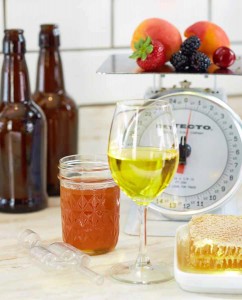
Recently, I interviewed Steve Piatz about his new book, “The Complete Guide to Making Mead: The Ingredients, Equipment, Processes, and Recipes for Crafting Honey Wine” (2014, Voyageur Press). Steve has been a mead maker for a long time, going back to the days when there was practically no information on mead making and people were still boiling their mead musts. Since then, he has won numerous awards for his meads, including the 2008 AHA Meadmaker of the Year Award. He is also a mead judge.
Piatz says his book is organized around the BJCP guidelines for judging mead. In addition to detailing the styles of mead, it lists the different types of honey, and their characteristics, as well as the relevant yeast strains and the characters they impart. There are also lots of recipes and a section on recipe development. For first-time mead makers, there is also a section with step by step instructions for making mead.
I asked him what he would recommend for the first time mead maker. He said that making a semi-sweet orange blossom honey mead is a good idea. The ingredients are easy to come by and it is easy to make.
Improving Meads
Steve has also judged a lot of meads in his life and I asked him, based on his judging experience, what the average mead maker could do to improve his or her skills. Piatz felt that learning more about balance in mead — the interaction of the sweetness and acidity — and how to adjust it is something mead makers need to learn to progress beyond following a recipe to evaluating and adjusting their meads. He also said that spiced meads were frequently overdone and learning subtlety is something beginning mead makers should strive towards.
I also asked him whether a mead maker’s techniques or the ingredients were more important. Obviously both play a role, and Piatz felt that doing staggered nutrient additions was important to making quality mead, but that sanitation was less critical in mead making due to the lower acidity and potentially higher levels of alcohol involved. Beyond that, mead making is similar to winemaking in that the characteristics of the ingredients largely determine the quality the final product.
Evaluating Honey
Along those lines, I asked him how mead makers could find good honey and evaluate its mead making potential. Piatz said that mead makers should get to know the varieties of honey, but it’s hard to know what’s in any particular honey until you try it. As an example, he said that a lot of spring honey’s in the Midwest were “yucky,” but that summer and fall honeys were generally better. He also said that California orange blossom honeys were better than those from Florida. So, simply knowing the variety of honey doesn’t tell you everything. He urged mead makers to taste their honey before making mead from it, but cautioned that it is hard to tell how a mead will taste from the taste of the honey. A lot can happen in fermentation and it’s hard to predict. So, essentially, knowing the honey variety, where and when it was made, and what it tastes like is a starting point in determining the suitability of given honey, but you still have ferment it to see how it will taste.
Water
Water is a hot topic in home beer making these days, so I asked him about water in mead making. Piatz felt that somewhat chalky water, as is found in much of the upper Midwest, is beneficial to mead making as mead musts can be quite acidic. For mead makers with soft water, he recommended treating it with potassium hydroxide.
Blending
Finally, I asked him for advice for advanced home mead makers. He said there wasn’t anything new and radical out there, but that he thought that many mead makers could benefit from exploring blending.
When I first met Piatz, many years ago, he was best known for his sours and I asked him if he still brewed sours and if there was a sour beer book in the works. He’s still making sours, including experimenting with aging them in whiskey barrels, but there’s no plans currently for him to write a book about them.
—
Related articles


In your book page 124 the Buckwheat recipe is not correct. The 9.5 pounds of honey will not result in 1.080 gravity for 5 gallons of must, it takes more like 11 pounds of honey.
Comments?